Efficiency Analysis of the Coastal Port Group in the Yangtze River Delta
Abstract
1. Introduction
2. Theoretical Model
2.1. Three-Stage DEA Model
2.1.1. First Stage: BCC Model
2.1.2. Second Stage: SFA Model
2.1.3. The Third Stage: The Adjusted DEA Model
2.2. Malmquist Index Method
3. Indicator Selection and Data Sources
3.1. Establishment of Evaluation Index System
3.1.1. Determination of Input and Output Indicators
- The number of berths for production (number). Suppose the number of berths is too low. In that case, the ship will not be able to start production immediately after arriving at the wharf and can only wait outside the wharf until there are free berths to berth, which delays much time and seriously affects the work efficiency of the port.
- Length of the wharf for production (in meters). The length of the production wharf serves as an important production indicator because it mostly influences the number of berths at each port. The longer the wharf is, the more berths can be created.
- Cargo throughput (10,000 tons): Cargo throughput refers to the amount of cargo that enters or leaves the port and is loaded and unloaded by water transport within a certain period, usually measured over the year. This indicator is the leading indicator to measure the production level.
- Container throughput (10,000 TEU): Container throughput refers to the number of containers entering and leaving the port within a certain period in units of 20-foot containers, which is usually measured over the year. Through this indicator, the development and operation of the port can be evaluated.
3.1.2. Determination of Environmental Factor Indicators
- The total import and export volume of port cities. The import and export trade volume within the region is the primary source of demand for ports. The transportation of coastal ports is the basis for developing foreign trade, which reflects the operation of the port to a certain extent. The volume of import and export trade will directly affect the operation of the port.
- The Gross Domestic Product (GDP) of port cities. The GDP of a city where a port is located can directly reflect the region’s economic development. The better the city’s economic development, the more demand it can provide for the port in the region, which can increase the use of the port and improve its throughput quantity, thus having a particular impact on the efficiency.
3.2. Selection of Samples and Data Sources
4. An Empirical Analysis of the Efficiency Evaluation of the Coastal Port Groups in the Yangtze River Delta
4.1. Static Efficiency Analysis of the Coastal Port Group in the Yangtze River Delta
4.1.1. First Stage of DEA Efficiency Value Analysis
4.1.2. Second Stage SFA Regression Analysis
- The environmental factor of the total import and export volume of port cities is beneficial to the slack variables of the two input indicators, as import and export and trade have a positive relationship. The increase in the total import will positively promote and impact the throughput and output of the port. In contrast, the expansion of the total import and export will stimulate the throughput of the port, which will directly lead to the throughput increasing, which expands the scale of the port and effectively solves the problem of waste of resources. As a result, the efficiency of the port has been improved.
- The port city GDP is unfavorable for the relaxation variable of the two input indicators. That is, the increase in the environmental variable of port city GDP will lead to a rise in the input relaxation variable. The results show that the effect of the port city GDP on the relaxation variable of the two inputs is negative. This means that with the growth of the port city’s GDP and economic prosperity, the government will continue to increase investment in ports. There is an excessive investment. Still, the profits of ports are not as high as expected, but this will lead to a decline in the efficiency of the ports.
4.1.3. Third Stage DEA Measure
4.2. Dynamic Efficiency Analysis of the Yangtze River Delta Coastal Port Group
4.2.1. Analysis of Dynamic Efficiency in Each Year
4.2.2. Dynamic Efficiency Analysis of Port Groups and Ports
5. Conclusions and Recommendations
- Strengthen the cooperation of ports within the port group, effectively integrate internal resources, form comprehensive advantages, plan rationally, and break through the restrictions of administrative divisions and fight alone. Adopt a strategy of cooperation and win-win and formulate a cluster-type development plan. Optimize the allocation of port resources. Give full play to the advantages of the Ningbo-Zhoushan Port Deep-water Port and the advantages of the Shanghai Port Shipping Center. Narrow the differences in port development, take dislocation development and character development as the goal, establish a regional economic integration development pattern, and improve the international competitiveness of all Chinese ports.
- Increase the introduction of advanced technology and equipment in various ports and spend more in new technology research and development. Acquire advanced management experience and integrate with the world’s advanced level to form core competitiveness. Improve infrastructure construction and deep-water berth construction, improve China’s port development environment, breakthrough port development bottlenecks, rationally plan port scale, avoid excessive port expansion, effectively improve port production efficiency, and optimize resources. Use physical equipment and clean energy and improve energy efficiency. Improve the management level by optimizing the port operation management system through peak regulation.
- Accelerate the upgrading of the port industry, accelerate the construction of intelligent ports, strengthen the integration with other industries, drive the formation and development of new industries, and form a diversified development pattern of ports. Develop new industries such as tourism, boutique cruise ships, and modern logistics, and build tourism and modern comprehensive trade ports, which will gradually expand the functions of the port. It is necessary to make overall plans to further promote the integrated development of the port city so that the development of the port can promote the economic improvement of the hinterland city.
- The main conclusions we have drawn show that studying the Yangtze River Delta port group to dig out the potential of the port group improves the competitiveness of China’s port. Help the optimal allocation of port resources in the port group system, ensure the smooth flow and security of the international logistics supply chain, and promote the high-quality development of China’s ports.
- The efficiency of the Yangtze River Delta port cluster and the optimization strategy formulated by this calculation is systematic and comprehensive and fill the application gaps. However, some indicators such as the port accessibility are not considered as the three ports discussed are nearly the same in this regard. Therefore, we plan to add the discussion on the impact of port accessibility for the evaluation of small ports in the future.
Author Contributions
Funding
Institutional Review Board Statement
Informed Consent Statement
Data Availability Statement
Conflicts of Interest
References
- Huo, W.; Zhang, W.; Chen, P.S. Recent development of Chinese port cooperation strategies. Res. Transp. Bus. Manag. 2018, 26, 67–75. [Google Scholar] [CrossRef]
- Notteboom, T.; Yang, Z. Port governance in China since 2004: Institutional layering and the growing impact of broader policies. Res. Transp. Bus. Manag. 2017, 22, 184–200. [Google Scholar] [CrossRef]
- Wang, C.; Ducruet, C.; Wang, W. Port integration in China: Temporal pathways, spatial patterns and dynamics. Chin. Geogr. Sci. 2015, 25, 612–628. [Google Scholar] [CrossRef]
- Jia, S.; Li, S.; Lin, X.; Chen, X. Scheduling Tugboats in a Seaport. Transp. Sci. 2021, 55, 1370–1391. [Google Scholar] [CrossRef]
- Shuai, J.; Lingxiao, W.; Qiang, M. Joint Scheduling of Vessel Traffic and Pilots in Seaport Waters. Transp. Sci. 2020, 54, 1495–1515. [Google Scholar] [CrossRef]
- Shuqin, L.; Shuai, J. The seaport traffic scheduling problem: Formulations and a column-row generation algorithm. Transp. Res. Part B 2019, 128, 158–184. [Google Scholar]
- Lingxiao, W.; Shuai, J.; Shuaian, W. Pilotage planning in seaports. Eur. J. Oper. Res. 2020, 287, 90–105. [Google Scholar]
- Shuai, J.; Chung-Lun, L.; Zhou, X. Managing Navigation Channel Traffic and Anchorage Area Utilization of a Container Port. Transp. Sci. 2019, 53, 728–745. [Google Scholar] [CrossRef]
- García, G.F.; Recio, J.M.B.; Echeverría, R.S.; Hernández, E.G.; Vargas, E.Z.; Duran, R.A.; Kahl, J.W. Estimation of atmospheric emissions from maritime activity in the Veracruz port, Mexico. J. Air Waste Manag. Assoc. 2021, 71, 934–948. [Google Scholar] [CrossRef]
- Lin, B.; Chen, Y. Will economic infrastructure development affect the energy intensity of China’s manufacturing industry? Energy Policy 2019, 132, 122–131. [Google Scholar] [CrossRef]
- Ma, X.; Wang, C.; Dong, B.; Gu, G.; Chen, R.; Li, Y.; Zou, H.; Zhang, W.; Li, Q. Carbon emissions from energy consumption in China: Its measurement and driving factors. Sci. Total Environ. 2018, 648, 1411–1420. [Google Scholar] [CrossRef] [PubMed]
- Feng, C.; Xia, Y.S.; Sun, L.X. Structural and social-economic determinants of China’s transport low-carbon development under the background of aging and industrial migration. Environ. Res. 2020, 188, 109701. [Google Scholar] [CrossRef] [PubMed]
- Hoffmann, J. Review of Maritime Transport, 2011; United Nations Conference on Trade and Development; United Nations: New York, NY, USA, 2017.
- Cullinane, K.; Wang, T.F. Port governance in China. Res. Transp. Econ. 2007, 17, 331–356. [Google Scholar] [CrossRef]
- Xu, M.; Chin, A.T.H. Port governance in China: Devolution and effects analysis. Procedia-Soc. Behav. Sci. 2012, 43, 14–23. [Google Scholar] [CrossRef][Green Version]
- Zhuang, P.; Song, D.W. Discussing Port Governance Issues at the Regional Level: A Tale of Zhejiang Province in China. In Proceedings of the International Association of Maritime Economists Conference, Kyoto, Japan, 27–30 June 2017. [Google Scholar]
- Wang, L.H.; Zhu, Y. Study on the status of Shanghai Port in the “21st Century Maritime Silk Road”. Hum. Geogr. 2018, 33, 121–129. [Google Scholar]
- Ren, J.; Dong, L.; Sun, L. Competitiveness prioritisation of container ports in Asia under the background of China’s Belt and Road initiative. Trans. Rev. 2018, 38, 436–456. [Google Scholar] [CrossRef]
- Shuai, J.; Qiang, M.; Haibo, K. Equitable Vessel Traffic Scheduling in a Seaport. Transp. Sci. 2021, 56, 162–181. [Google Scholar]
- Drewry. Global Container Terminal Operators: Annual Report 2014; Drewry Maritime Research: London, UK, 2022. [Google Scholar]
- Caldeirinha, V.; Felício, J.A.; Salvador, A.S.; Nabais, J.; Pinho, T. The impact of port community systems (PCS) characteristics on performance. Res. Transp. Econ. 2020, 80, 100818. [Google Scholar] [CrossRef]
- Felício, J.; Caldeirinha, V.; Dionísio, A. The effect of port and container terminal characteristics on terminal performance. Marit. Econ. Log. 2015, 17, 493–514. [Google Scholar] [CrossRef]
- Hwang, C.C.; Chiang, C.H. Cooperation and competitiveness of intra-regional container ports. J. East. Asia Soc. Transp. Stud. 2014, 8, 2254–2269. [Google Scholar]
- Yap, W.Y.; Lam, J.S.L. An interpretation of inter-container port relationships from the demand perspective. Marit. Policy Manag. 2006, 31, 337–355. [Google Scholar] [CrossRef]
- Song, D.W. Port co-opetition in concept and practice. Marit. Policy Manag. 2003, 30, 29–44. [Google Scholar] [CrossRef]
- Cullinane, K.; Teng, Y.; Wang, T.F. Port competition between Shanghai and Ningbo. Marit. Policy Manag. 2005, 32, 331–346. [Google Scholar] [CrossRef]
- Li, J.B.; Oh, Y.S. A research on competition and cooperation between Shanghai port and Ningbo-Zhoushan port. Asian J. Shipp. Log. 2010, 26, 67–92. [Google Scholar] [CrossRef]
- Fuentes García, G.; Sosa Echeverría, R.; Baldasano Recio, J.M.; WKahl, J.D.; Antonio Durán, R.E. Review of Top-Down Method to Determine Atmospheric Emissions in Port. Case of Study: Port of Veracruz, Mexico. J. Mar. Sci. Eng. 2022, 10, 96. [Google Scholar] [CrossRef]
- Espinosa, A.A.; Miranda, J.; Hernández, E.; Reyes, J.; Alarcón, A.L.; Torres, M.C.; Sosa, R. Temporal variation of suspended particles (TSP, PM10, and PM2.5) and chemical composition of PM10 in a site at the coast of the Gulf of Mexico. Air Qual. Atmos. Health 2019, 12, 1267–1277. [Google Scholar] [CrossRef]
- Van Hoek, R.I.; Erasmus, I. From reversed logistics to green supply chains. Log. Solut. 2000, 2, 28–33. [Google Scholar] [CrossRef]
- Felício, J.A.; Rodrigues, R.; Caldeirinha, V. Green Shipping Effect on Sustainable Economy and Environmental Performance. Sustainability 2021, 13, 4256. [Google Scholar] [CrossRef]
- Wei, H.; Nian, M.; Li, L. China’s Strategies and Policies for Regional Development during the Period of the 14th Five-Year Plan. Chin. J. Urban Environ. Stud. 2020, 8, 2050008. [Google Scholar] [CrossRef]
- Fried, H.O.; Lovell, C.A.K.; Schmidt, S.S.; Yaisawarng, S. Accounting for environmental effects and statistical noise in data envelopment analysis. J. Prod. Anal. 2002, 17, 157–174. [Google Scholar] [CrossRef]
- Wang, L.; Bi, Z. Research on the efficiency of major inland river ports in my country based on the three-stage DEA model. Ind. Econ. Res. 2010, 4, 40–48. [Google Scholar]
- Aihu, W.; Wenling, W. Evaluating the efficiency of the Pearl River Delta ports based on three-stage DEA model. Ind. Eng. J. 2017, 20, 82. [Google Scholar]
- Tongzon, J. Efficiency measurement of selected Australian and other international ports using data envelopment analysis. Transp. Res. Part A Policy Pract. 2001, 35, 107–122. [Google Scholar] [CrossRef]
- Wu, Y.C.J.; Goh, M. Container port efficiency in emerging and more advanced markets. Transp. Res. Part E 2010, 46, 1030–1042. [Google Scholar] [CrossRef]
- Xiao, X.H.; Song, B.L. Analysis and Evaluation of Dynamic Efficiency of Major Domestic Coastal Ports Based on DEA-Malmquist Index. J. Shanghai Marit. Univ. 2021, 42, 81–86. [Google Scholar]
- China Ports. China Port Yearbook 2016–2020. Available online: http://www.port.org.cn/ (accessed on 25 June 2022).
- National Bureau of Statistics. China Statistical Yearbook 2016–2020. Available online: http://www.stats.gov.cn/tjsj./ndsj/ (accessed on 25 June 2022).
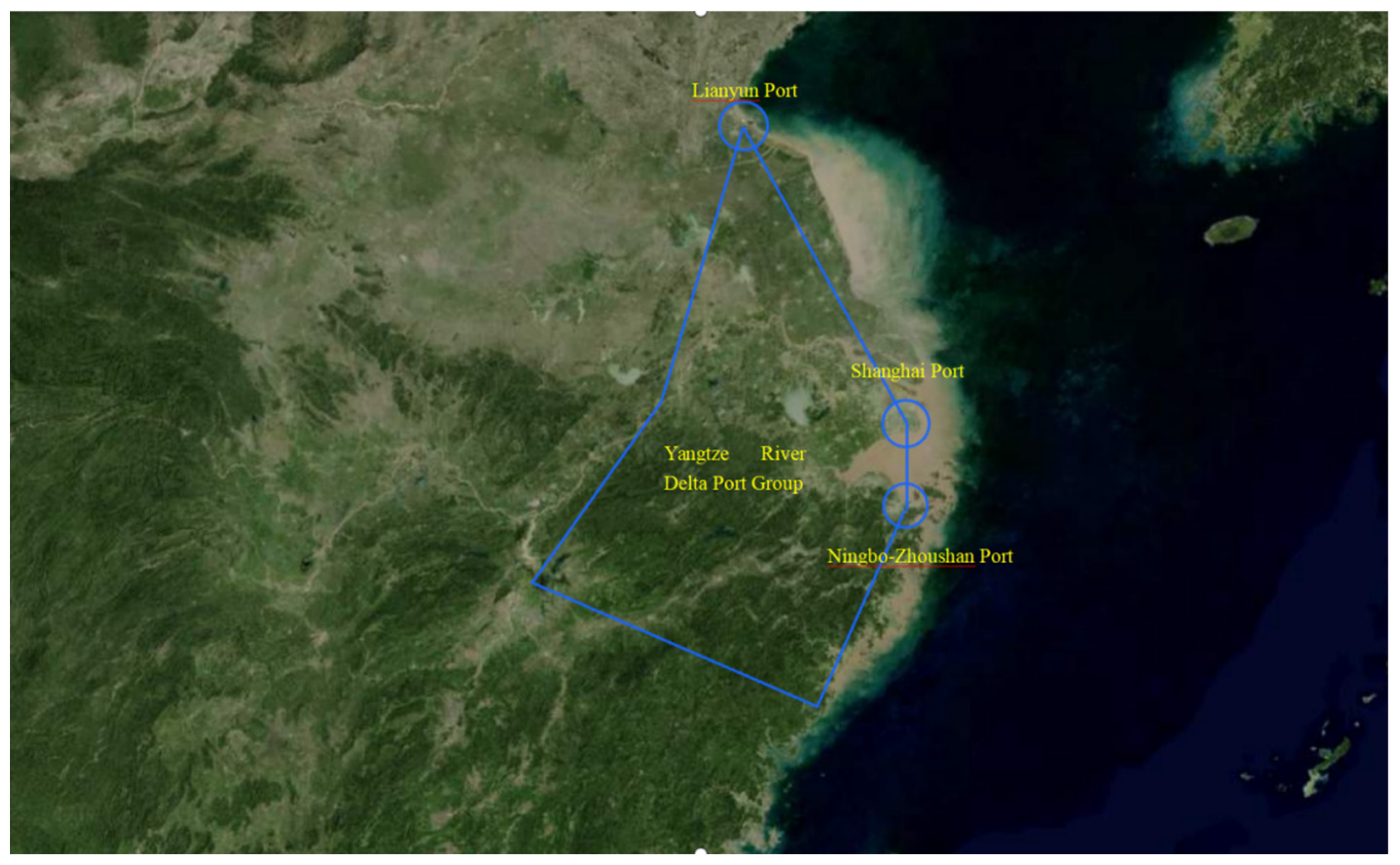


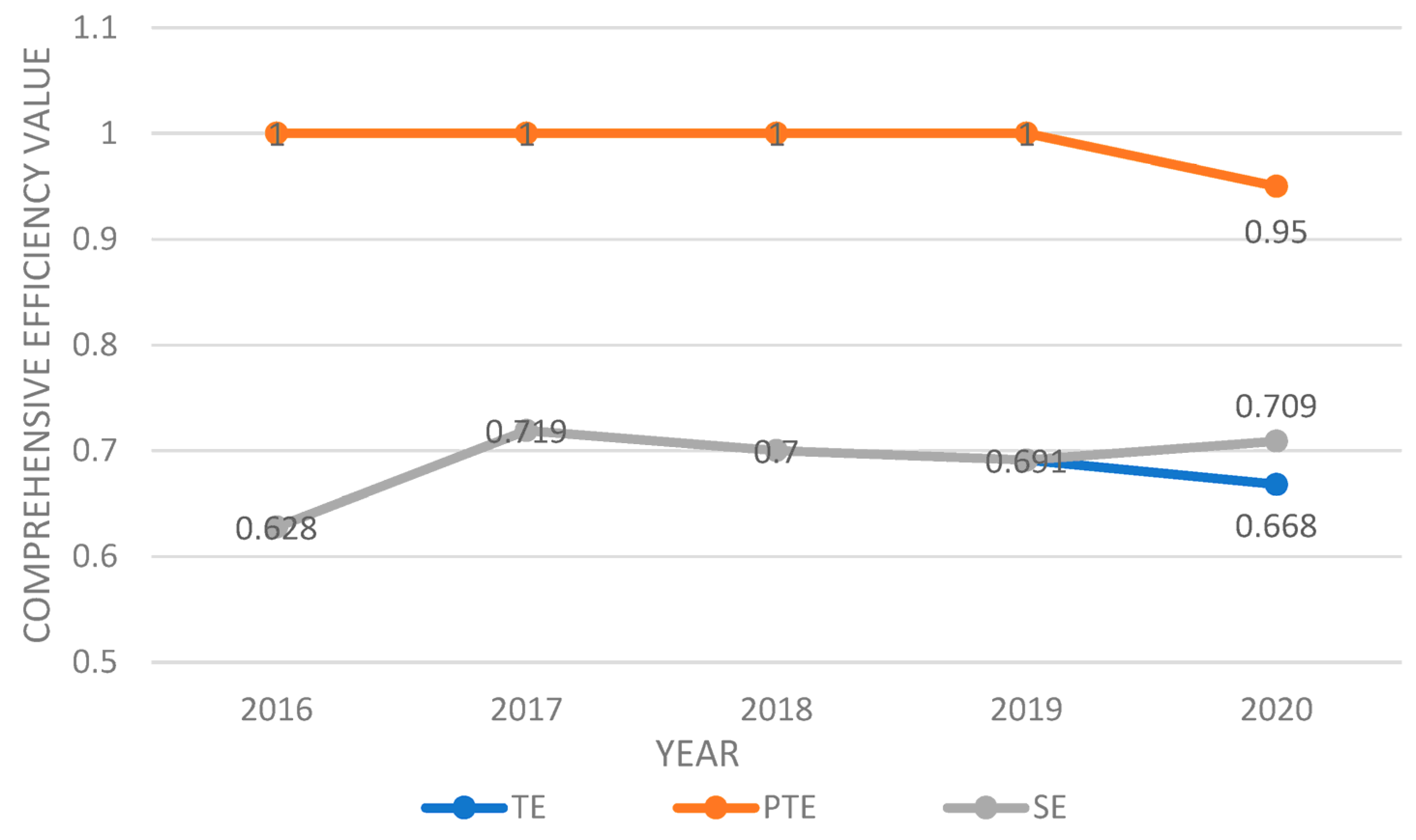
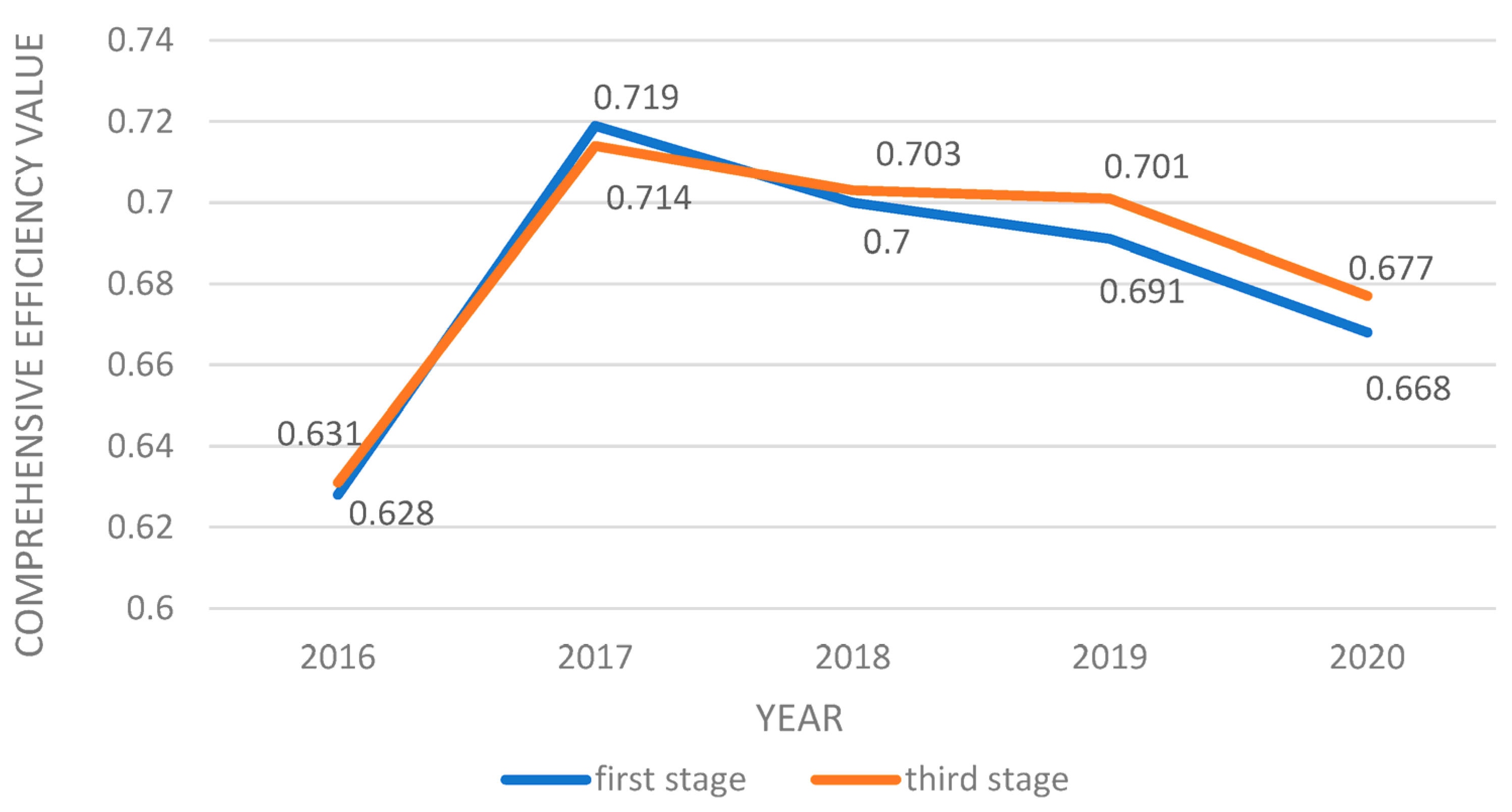
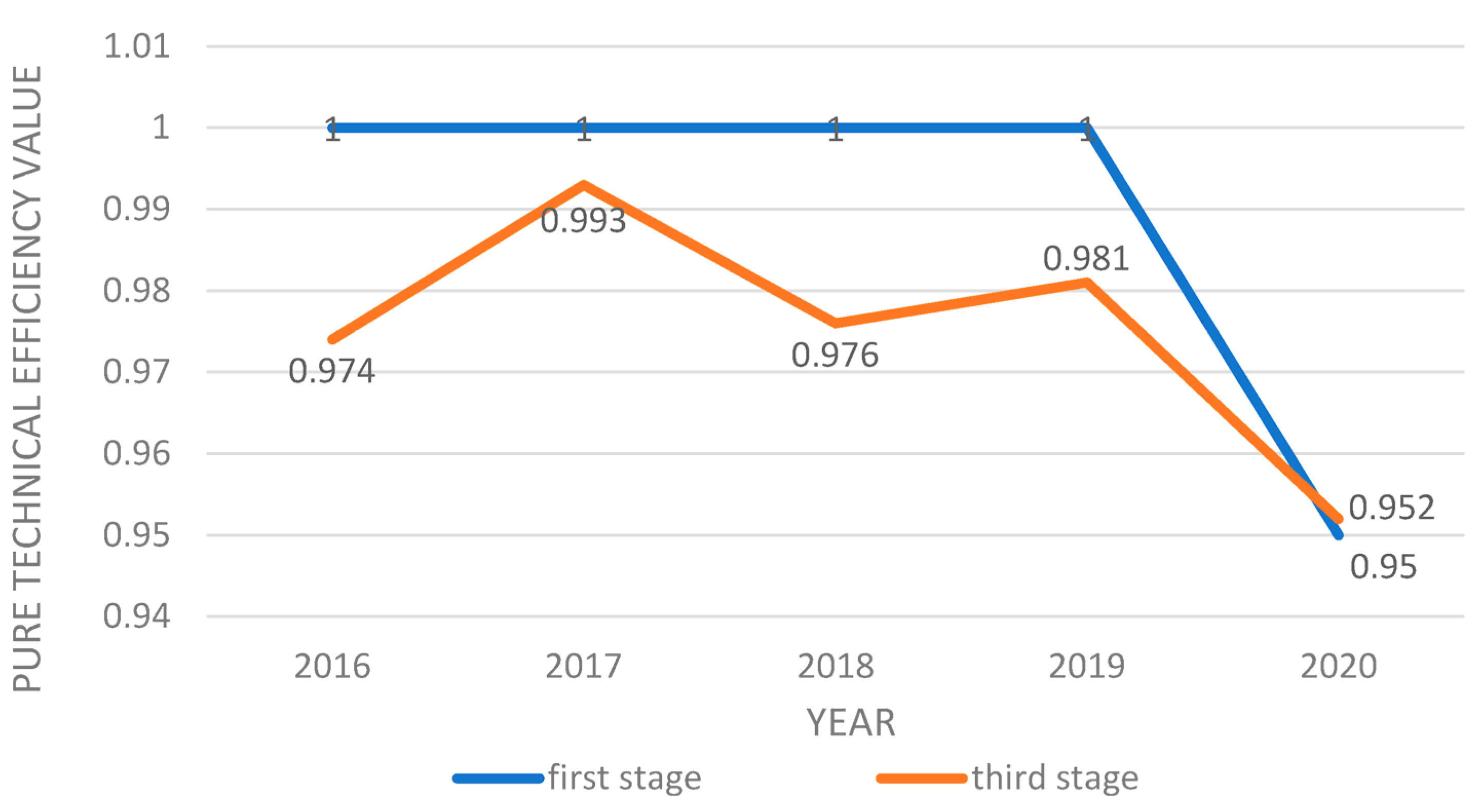

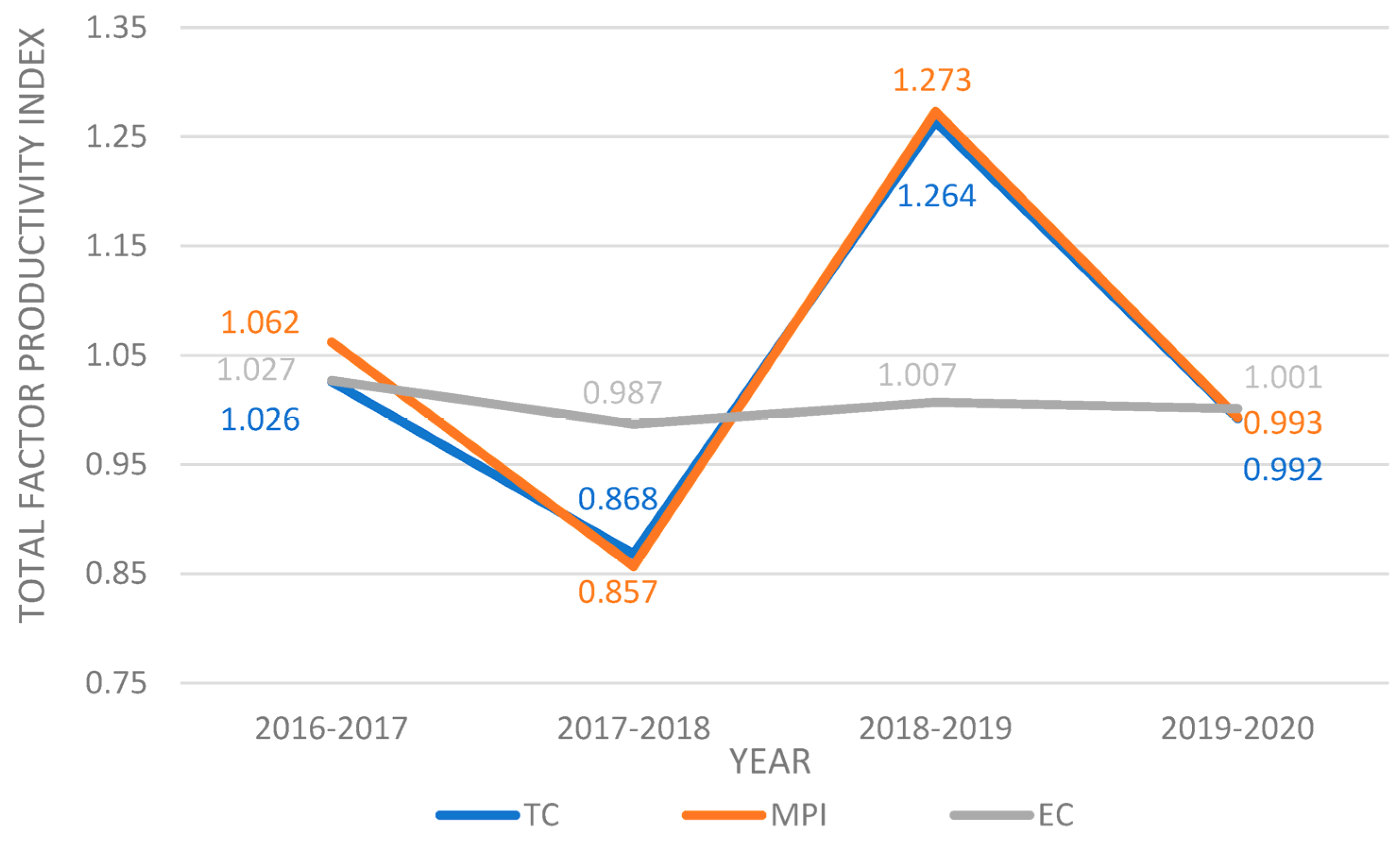
| Index | Mean |
|---|---|
| n | The number of decision-making units |
| m | Number of inputs |
| t | Number of outputs |
| Input slack variable | |
| Output slack variable value | |
| xir | Input indicators |
| yjr | Output indicators |
| θ | The value of TE; if = 1, the decision-making unit is said to be valid, otherwise it is invalid. |
| Index | Mean |
|---|---|
| Sni | The slack value of the nth input of the ith decision unit |
| Zi | Environment variable |
| βn | Coefficients of Environmental Variables |
| vni + μni | Mixed error term |
| vni | Random interference |
| μni | Management inefficiency, subject to a normal distribution truncated at zero, i.e., μ~N+ (0, σv2) |
| V~N (0, σv2) | Random error term |
| Adjusted input | |
| Xni | Investment before adjustment |
| ε= v − μ | Mixed error term |
| Year | Port | Technical Efficiency | Pure Technical Efficiency | Scale Efficiency | Returns to Scale |
|---|---|---|---|---|---|
| 2016 | Shanghai Port | 0.671 | 1 | 0.671 | drs |
| Ningbo-Zhoushan Port | 0.549 | 1 | 0.549 | drs | |
| Lianyungang Port | 0.663 | 1 | 0.663 | irs | |
| Yangtze River Delta Port Group | 0.628 | 1 | 0.628 | -- | |
| 2017 | Shanghai Port | 0.768 | 1 | 0.768 | drs |
| Ningbo-Zhoushan Port | 0.636 | 1 | 0.636 | drs | |
| Lianyungang Port | 0.752 | 1 | 0.752 | irs | |
| Yangtze River Delta Port Group | 0.719 | 1 | 0.719 | -- | |
| 2018 | Shanghai Port | 0.758 | 1 | 0.758 | drs |
| Ningbo-Zhoushan Port | 0.633 | 1 | 0.633 | drs | |
| Lianyungang Port | 0.709 | 1 | 0.709 | irs | |
| Yangtze River Delta Port Group | 0.7 | 1 | 0.7 | -- | |
| 2019 | Shanghai Port | 0.749 | 1 | 0.749 | drs |
| Ningbo-Zhoushan Port | 0.595 | 1 | 0.595 | drs | |
| Lianyungang Port | 0.73 | 1 | 0.73 | irs | |
| Yangtze River Delta Port Group | 0.691 | 1 | 0.691 | -- | |
| 2020 | Shanghai Port | 0.726 | 1 | 0.726 | drs |
| Ningbo-Zhoushan Port | 0.593 | 1 | 0.593 | drs | |
| Lianyungang Port | 0.686 | 0.849 | 0.808 | irs | |
| Yangtze River Delta Port Group | 0.668 | 0.95 | 0.709 | -- |
| Yangtze River Delta Port Group | TE | PTE | SE |
|---|---|---|---|
| 2016 | 0.628 | 1 | 0.628 |
| 2017 | 0.719 | 1 | 0.719 |
| 2018 | 0.7 | 1 | 0.7 |
| 2019 | 0.691 | 1 | 0.691 |
| 2020 | 0.668 | 0.95 | 0.709 |
| Mean | 0.681 | 0.99 | 0.689 |
| Dependent Variable | Production Berth Slack | Production Wharf Length Slack | ||||
|---|---|---|---|---|---|---|
| - | Coefficient | Standard Error | T-Value | Coefficient | Standard Error | T-Value |
| Constant term | −71.7338 *** | 0.9913 | −72.3643 | −4127.8979 *** | 1 | −4127.8629 |
| Total import and export of port cities | −0.0078 ** | 0.0021 | −3.7124 | −0.4492 | 0.2991 | −1.502 |
| Port city GDP | 0.0088 ** | 0.0014 | 6.1849 | 0.5100 *** | 0.0636 | 8.0203 |
| σ2 | 8773.8683 *** | 1 | 8773.8804 | 119,935,070.0000 *** | 1 | 1.2 × 108 |
| γ | 0.9999 *** | 0.0002 | 4382.6898 | 0.9999 *** | 0 | 34,448,179 |
| Log likelihood | −81.5118 *** | −149.8594 *** | ||||
| LR test value | 7.2125 ** | 9.0469 *** | ||||
| Year | Port | Technical Efficiency | Pure Technical Efficiency | Scale Efficiency | Returns to Scale |
|---|---|---|---|---|---|
| 2016 | Shanghai Port | 0.766 | 1 | 0.766 | drs |
| Ningbo-Zhoushan Port | 0.592 | 1 | 0.592 | drs | |
| Lianyungang Port | 0.535 | 0.923 | 0.58 | irs | |
| Yangtze River Delta Port Group | 0.631 | 0.974 | 0.646 | -- | |
| 2017 | Shanghai Port | 0.856 | 1 | 0.856 | drs |
| Ningbo-Zhoushan Port | 0.672 | 1 | 0.672 | drs | |
| Lianyungang Port | 0.614 | 0.98 | 0.626 | irs | |
| Yangtze River Delta Port Group | 0.714 | 0.993 | 0.718 | -- | |
| 2018 | Shanghai Port | 0.855 | 1 | 0.855 | drs |
| Ningbo-Zhoushan Port | 0.667 | 1 | 0.667 | drs | |
| Lianyungang Port | 0.586 | 0.927 | 0.632 | irs | |
| Yangtze River Delta Port Group | 0.703 | 0.976 | 0.718 | -- | |
| 2019 | Shanghai Port | 0.855 | 1 | 0.855 | drs |
| Ningbo-Zhoushan Port | 0.644 | 1 | 0.644 | drs | |
| Lianyungang Port | 0.604 | 0.944 | 0.64 | irs | |
| Yangtze River Delta Port Group | 0.701 | 0.981 | 0.713 | -- | |
| 2020 | Shanghai Port | 0.787 | 1 | 0.787 | drs |
| Ningbo-Zhoushan Port | 0.62 | 1 | 0.62 | drs | |
| Lianyungang Port | 0.625 | 0.857 | 0.729 | irs | |
| Yangtze River Delta Port Group | 0.677 | 0.952 | 0.712 | -- | |
| 2016–2020 | The average value of the Yangtze River Delta port group | 0.685 | 0.975 | 0.701 | -- |
| Year | Changes in Comprehensive Technical Efficiency | Technological Progress Changes | Pure Technical Efficiency Change | Scale Efficiency Changes | Malmquist Index |
|---|---|---|---|---|---|
| 2016–2017 | 1.035 | 1.026 | 1.007 | 1.027 | 1.062 |
| 2017–2018 | 0.987 | 0.868 | 1 | 0.987 | 0.857 |
| 2018–2019 | 1.007 | 1.264 | 1 | 1.007 | 1.273 |
| 2019–2020 | 1.001 | 0.992 | 1 | 1.001 | 0.993 |
| Mean | 1.007 | 1.028 | 1.002 | 1.005 | 1.036 |
| Port Group | Port | Changes in Comprehensive Technical Efficiency | Technological Progress Changes | Pure Technical Efficiency Change | Scale Efficiency Changes | Malmquist Index |
|---|---|---|---|---|---|---|
| Yangtze River Delta Port Group | Shanghai Port | 1.024 | 0.945 | 1.005 | 1.019 | 0.968 |
| Ningbo-Zhoushan Port | 1 | 1.008 | 1 | 1 | 1.008 | |
| Lianyungang Port | 0.997 | 1.141 | 1 | 0.997 | 1.138 | |
| Yangtze River Delta Port Group | 1.007 | 1.028 | 1.002 | 1.005 | 1.036 |
Publisher’s Note: MDPI stays neutral with regard to jurisdictional claims in published maps and institutional affiliations. |
© 2022 by the authors. Licensee MDPI, Basel, Switzerland. This article is an open access article distributed under the terms and conditions of the Creative Commons Attribution (CC BY) license (https://creativecommons.org/licenses/by/4.0/).
Share and Cite
Yu, S.; Gong, L.; Qi, M. Efficiency Analysis of the Coastal Port Group in the Yangtze River Delta. J. Mar. Sci. Eng. 2022, 10, 1575. https://doi.org/10.3390/jmse10111575
Yu S, Gong L, Qi M. Efficiency Analysis of the Coastal Port Group in the Yangtze River Delta. Journal of Marine Science and Engineering. 2022; 10(11):1575. https://doi.org/10.3390/jmse10111575
Chicago/Turabian StyleYu, Siqin, Lina Gong, and Mingyun Qi. 2022. "Efficiency Analysis of the Coastal Port Group in the Yangtze River Delta" Journal of Marine Science and Engineering 10, no. 11: 1575. https://doi.org/10.3390/jmse10111575
APA StyleYu, S., Gong, L., & Qi, M. (2022). Efficiency Analysis of the Coastal Port Group in the Yangtze River Delta. Journal of Marine Science and Engineering, 10(11), 1575. https://doi.org/10.3390/jmse10111575






